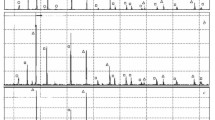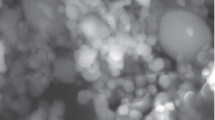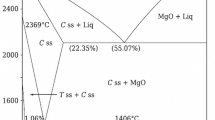The dependence of the resistance of basic refractories to high-temperature plastic deformation under load on the amount of zirconium dioxide modifying additive is reported. Creep curves are presented and analyzed. ZrO2 nanoparticles (average particle size 100 nm) were added to the composition in the range 0.25 – 0.75 wt %. The resistance to high-temperature plastic deformation was significantly improved and was due to the interaction of the ZrO2 additive with CaO contained in the synthetic periclase obtained by precipitation. Increasing the amount of ZrO2 additive above 0.5 wt % was found not to have a significant effect.
Similar content being viewed by others
Avoid common mistakes on your manuscript.
Introduction
The ability to control the properties of a material enables its service life to be increased significantly. Today, many aggregates exist where refractories experience high temperatures and several other loads. One of the most common is a compressive load, which often leads to plastic deformation of a lining. In such instances, the resistance of an actual aggregate will depend significantly on the ability of the material to counteract the deformation. ZrO2 nanoparticles were shown to be capable of significantly modifying the structure of a high-purity refractory manufactured from synthetic periclase [1]. Also, the formation of a new phase (calcium zirconate CaZrO3) was found to lead to redistribution of a CaO precursor in the refractory structure, thereby increasing the number of direct bonds between separate crystals and periclase grains [2]. The high-temperature and stable phase CaZrO3 could also improve the high-temperature parameters. Also, the question of the optimal amount of an additive remains poorly understood. The present work determined the effect of the amount of ZrO2 nanoparticle additive on the high-temperature deformation under load.
Experimental
Synthetic periclase obtained from sea water was used as the main raw material. The typical chemical composition (wt %) of the periclase was MgO 98.5, CaO 0.74, SiO2 0.12, B2O3 0.01, Al2O3 0.07, Fe2O3 0.44, MnO2 0.12. ZrO2 micropowder obtained in pulsed-plasma reactors was used as the modifying additive. The features of this additive were high chemical purity (ZrO2 + Y2O3 97.6 wt %; Hf2O3 2.4 wt %) and rounded particles (Fig. 1).
The amount of additive needed for the research was determined using the following assumptions. All added ZrO2 was considered capable of reacting with CaO (the CaO content in the raw material was ~0.74 wt %). Considering that part of the CaO was situated within the periclase grains and could not physically contact the additive, the amount of CaO available for chemical reactions was taken as 50% of the total amount (0.74 × 0.5 = 0.37 wt %). The molar masses were CaO 56.1 g/mol; ZrO2, 123.2 g/mol. The amount of ZrO2 additive needed for the maximal completion of the calcium zirconate formation reaction with the above assumption was determined using proportions (0.37 × 123.2/56.1 = 0.81 wt %). Samples with 0 (reference sample), 0.25, 0.5, and 0.75 wt % ZrO2 were examined as a solution considering the required calculated amount of ZrO2 additive.
Cylindrical samples of diameter and height 50 mm were fabricated by hydraulic compression according to DIN 993-1. The pressing pressure was 120 MPa. Table 1 lists the sample compositions. Then, the samples were fired in an electric laboratory furnace at 1700°C with holding at the maximum temperature for 3 h. Several physicomechanical parameters of the samples were determined after the firing (Table 2).
The open porosity and water absorption decreased insignificantly. The bulk density increased insignificantly, which may have been related to the difference in the true densities of the major component MgO and the additive ZrO2. The compression strength of the 0Z, 25Z, and 50Z samples increased although increasing the amount of ZrO2 further led to a slight decrease in the strength. The creep parameter decreased over the whole studied range (Fig. 2). In turn, this indicated a significant increase in resistance to plastic deformation (according to DIN 993-9).
Figure 3 shows for clarity the deformation curves of the plastic deformation of the samples.
Increasing the amount of ZrO2 additive to 0.5 wt.% led to a significant change in the behavior of the sample under a compression load. This was primarily manifested in the slope of the conditionally straight section of the curve. The total deformation decreased. The time of the first creep (time from the start of the experiment until reaching the arbitrarily straight part) decreased. Let us examine the obtained curves in more detail. The initial stage of the creep was characterized by a variable rate of plastic deformation. This circumstance was related to structural changes (compaction) [3]. Figure 4 shows deformation curves in the initial stage to evaluate the time after which the system stabilized and stage II of the creep began.
The duration of the creep stage I for sample 0Z was >150 min; 25Z, 88 min; 50Z, 60 min; and 75Z, 38 min. A clear trend in the amount of additive and the duration of stage I was observed.
Next, the curves were examined in the range 400 – 1200 min (Fig. 5). The interval was selected to examine the nearly linear part of the curve. This part allowed the slope characterizing the deformation in stage II to be determined.
In general, the trend was similar. An increase in the amount of additive led proportionally to a decrease in the slope, i.e., a decrease in the deformation rate. Nevertheless, this trend did not occur in all instances. Even visual inspection made it obvious that the creep curves for samples 50Z and 75Z would intersect at some point if the curves were mentally extrapolated. The slopes in degrees calculated from a given two points lying on a single line confirmed this (Table 3).
The calculations confirmed that the slope of the line for sample 75Z was greater than for sample 50Z. In turn, this suggested that sample 75Z deformed faster than 50Z in stage II. The question arose about how the sample with the lower creep parameter (Table 2) would ultimately deform more strongly. The answer lay in the method for calculating the creep parameter according to DIN 993-9, in which the total deformation in a given period was taken as the result and was divided by the time during which the deformation was examined (300 – 1200 min). This approach did not consider all intricacies of the deformation process. Next, the time dependences of the deformation rate under load were examined to study the dynamics of the change of deformation (Fig. 6).
The deformation rate clearly dropped in the order 0Z(25Z(50Z. The situation was somewhat different for samples 50Z and 75Z. The difference was rather clear in the primary creep stage although the deformations of samples 50Z and 75Z were very similar thereafter. Also, sections in time in which the deformation rate of sample 75Z was greater than that of sample 50Z were observed. This also confirmed the hypothesis that samples 75Z would have greater deformation in longer periods.
Conclusion
An additive of ZrO2 nanoparticles in the amount of 0.25 – 0.75 wt.% increased the resistance to high-temperature plastic deformation. Calcium zirconate formed by a chemical reaction between CaO and ZrO2 could considerably change the course and nature of high-temperature plastic deformation. Variation of the amount of added additive led expectedly to a change in the resistance of the sample to deformation. The trend was close to linear in the examined range. The deformation rate dropped by 18% for samples 25Z. The resistance to deformation of samples 50Z increased by 45%; of 75Z, by 54%. The most effective range of modification was 0.25 – 0.5%. The most clearly manifested positive changes were observed in this range. The duration of stage I decreased. The slope of the curve in stage II decreased. The deformation rate over the whole measurement range decreased. Stage I creep contracted further if the amount of additive was increased to 0.75 wt.%. However, increasing the amount of additive above a certain value had the opposite effect, despite the best final creep value according to DIN 993-9. The slope of the creep curve in stage II of samples 75Z increased as compared to that of sample 50Z (–0.009° and –0.007°, respectively). A visual inspection of the creep curves of samples 75Z and 50Z clearly showed that the curves intersected at a certain time. This circumstance indicated that the deformation of sample 75Z would be increased as compared to the total deformation of sample 50Z at longer times. Despite the increased deformation rate in stage II, samples 75Z had an important advantage in stage I (the duration of stage I was 38 min vs. 60 min for sample 50Z). In other words, samples 75Z were more stable at the start of deformation and showed the best result in the experiment for 1200 min. With respect to the long term, samples 50Z were more attractive. Presumably, the reason for this situation could be residual ZrO2 that did not react chemically with CaO for sample 75Z, although the calculations made at the start of the work on the determination of the required amount of additive turned out to be rather close to reality. The amount of additive for which ZrO2 was most completely reacted with CaO, did not leave free (unbound) additive, and gave the best resistance to plastic deformation was optimal.
References
L. V. García-Quinonez, L. F. Verdeja, D. Fernandez-Gonzalez, et al., “Study of the corrosion resistance on nano-ZrO2 doped MgO ceramic composites by copper slag,” Research Square [This is a preprint ; it has not been peer reviewed by a journal], Posted Aug. 17, 2020; https://doi.org/10.21203/rs.3.rs-58174/v1.
2. I. A. Datsko, “Modification of basic refractory structure by zirconium dioxide nanoparticles,” Nov. Ogneupory, No. 6, 39 – 43 (2023).
A. C. Firatli, “Sinterung von Mehrphasen-Keramik im Dreistoffsystem MgO–Al2O3–ZrO2 [MgO–AlO–ZrO],” Rheinisch-Westfalische Technische Hochschule, Aachen, 1982, pp. 8, 9.
Author information
Authors and Affiliations
Corresponding author
Additional information
Translated from Novye Ogneupory, No. 10, pp. 27 – 30, October, 2023
Rights and permissions
Springer Nature or its licensor (e.g. a society or other partner) holds exclusive rights to this article under a publishing agreement with the author(s) or other rightsholder(s); author self-archiving of the accepted manuscript version of this article is solely governed by the terms of such publishing agreement and applicable law.
About this article
Cite this article
Datsko, I.A. Influence of the Amount of ZrO2 Additive on the Creep of a Basic Refractory. Refract Ind Ceram 64, 537–540 (2024). https://doi.org/10.1007/s11148-024-00886-6
Received:
Published:
Issue Date:
DOI: https://doi.org/10.1007/s11148-024-00886-6










